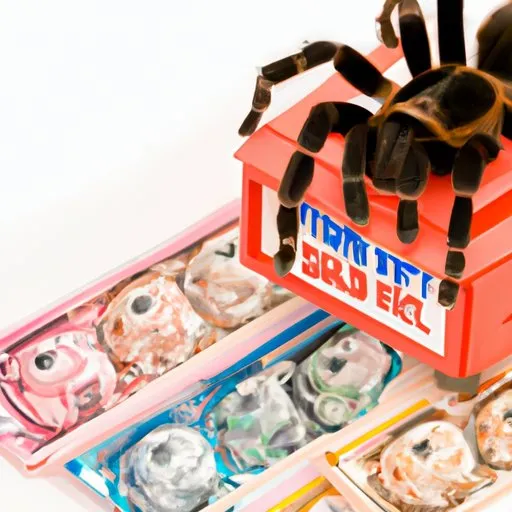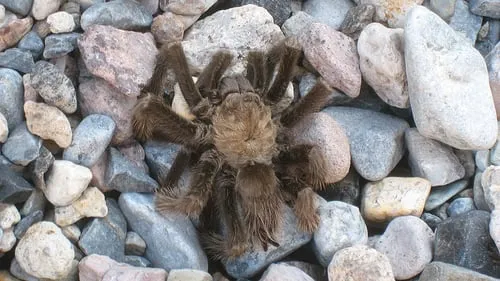What is the Average Cost of a Tarantula?
The cost of owning a tarantula can vary significantly based on several factors, making it crucial to understand the different aspects that influence the price. Generally, the initial cost of a tarantula itself can range from a few dollars to several hundred, depending on the species, age, and origin. However, the initial price is just the beginning. Ongoing costs like enclosure setup, food, and veterinary care must also be considered. This comprehensive guide will break down the different costs associated with getting and keeping a tarantula, helping you make an informed decision before bringing one of these fascinating creatures into your home. Understanding these expenses ensures you can provide your tarantula with the best possible care and a comfortable life.
Factors Influencing Tarantula Prices
Several factors influence the price of a tarantula, affecting both the initial purchase price and the ongoing expenses. These elements range from the tarantula’s specific species and age to where you acquire it. Being aware of these factors enables you to budget effectively and make informed decisions, guaranteeing that you select a tarantula that matches your budget and care capabilities. The origin of the tarantula, whether it’s captive-bred or wild-caught, also plays a role. Captive-bred tarantulas often cost more but are typically healthier and more acclimated to living in captivity. Wild-caught tarantulas, while potentially more affordable, might require additional care and acclimatization, adding to the overall cost of ownership.
Tarantula Species

Different tarantula species come with varying price tags. Rare and exotic species typically command higher prices compared to more common ones. The popularity of a species also influences its cost; sought-after tarantulas tend to be more expensive. For example, some vibrant or unique species, like certain Poecilotheria or Psalmopoeus, can be significantly pricier than more readily available varieties. The price difference often reflects the rarity of the species, the difficulty in breeding them, or the demand from collectors. Researching the specific species you are interested in is crucial to understanding the associated costs.
Tarantula Size and Age
The age and size of a tarantula can influence its cost. Spiderlings, or very young tarantulas, are generally cheaper than older, more established specimens. However, spiderlings require more specialized care and are more vulnerable. Sub-adults and adults, having already passed through their more delicate stages, often cost more. Size also plays a role; larger tarantulas, especially those nearing adulthood, may be priced higher. This reflects the time and resources invested in their growth and the reduced risk associated with their care.
Where You Buy a Tarantula
The source from which you purchase your tarantula can impact the price. Reputable breeders and specialized reptile stores usually have higher prices than informal sources. These sources often offer healthier specimens and provide better advice and after-sales support. Buying from a pet store, a reptile show, or an online marketplace like MorphMarket are also options. Each source has its pros and cons regarding price, selection, and the level of care and expertise you can expect. Be sure to compare prices and evaluate the seller’s reputation before making a purchase.
Ongoing Costs of Owning a Tarantula

Owning a tarantula involves more than just the initial purchase price. Ongoing costs, such as the enclosure setup, food, and veterinary care, contribute to the total expense of tarantula ownership. These costs can vary depending on the specific needs of the tarantula species and your care preferences. Planning for these recurring expenses is essential to providing a healthy and enriching environment for your pet. These are the expenditures that ensure your tarantula remains healthy, content, and thrives throughout its lifespan. Budgeting effectively will prevent unexpected financial burdens.
Enclosure and Setup
The enclosure setup is a crucial ongoing cost. The size and type of enclosure depend on the tarantula species and its size. Tarantulas require a well-ventilated enclosure with appropriate substrate, hiding places, and sometimes, decorations. The cost of a suitable enclosure can range from a few dollars for a small container for a spiderling to a considerable amount for a larger, more elaborate setup for an adult tarantula. Regular replacement of substrate and the addition of new decorations will also contribute to the ongoing expenses. Consider the specific needs of your chosen species when planning the setup to ensure it provides the appropriate environment.
Substrate and Decor
Substrate and decor are essential components of a tarantula’s enclosure, influencing both its physical and psychological well-being. The cost of substrate, such as coconut fiber, peat moss, or potting soil, varies depending on the type and quantity purchased. Decor, including hides, branches, and artificial plants, adds to the expense. The substrate needs to be changed regularly to maintain hygiene and prevent the buildup of harmful bacteria. Decor provides enrichment and can encourage natural behaviors, which also contributes to overall health. When choosing substrate and decor, consider the tarantula’s specific needs and preferences, as well as the aesthetic appeal of the setup.
Food and Supplements

Feeding your tarantula is a recurring cost. The diet of a tarantula primarily consists of live insects, such as crickets, mealworms, and roaches. The cost of these insects can vary depending on the supplier and the quantity purchased. Some tarantula owners also provide vitamin supplements to ensure their pet receives adequate nutrition. The frequency of feeding will depend on the tarantula’s age, size, and species. Regularly monitoring the tarantula’s eating habits and adjusting the diet as needed is essential to maintain its health and well-being. Planning for regular food expenses ensures that your tarantula consistently receives a balanced diet.
Veterinary Care
While tarantulas are generally low-maintenance pets, veterinary care is still a potential cost. Finding a veterinarian experienced in treating exotic animals is essential. Although tarantulas don’t typically require regular checkups, unexpected health issues can arise, leading to vet bills. The cost of veterinary care varies depending on the nature of the issue and the treatments required. Preventative measures, such as maintaining a clean enclosure and providing a proper diet, can help reduce the risk of health problems. It is wise to set aside a fund for potential veterinary expenses. Consider purchasing pet insurance that covers exotic pets, as some insurance plans will help cover the costs associated with veterinary care.
Hidden Costs to Consider
Beyond the obvious expenses, several hidden costs can impact the overall cost of owning a tarantula. These costs may not be immediately apparent but should be considered when budgeting for a new pet. Being aware of these hidden expenses can help you avoid financial surprises and ensure you provide your tarantula with the care it deserves. These hidden expenses can add up, so it’s best to be prepared for them.
Shipping Costs

If you purchase your tarantula from a breeder or supplier that is not local, shipping costs will be a factor. Shipping live animals requires special packaging and expedited services to ensure the tarantula’s safety and well-being during transport. The cost of shipping can vary depending on the distance, the shipping method, and the supplier’s policies. It is important to factor in the shipping cost when comparing prices from different sources. Shipping insurance may also be offered, adding to the overall cost.
Quarantine Period
When acquiring a new tarantula, a quarantine period is often recommended. This is a time to observe the new arrival for any signs of illness or parasites before introducing it to other pets. During this period, you may need to purchase a separate enclosure and provide special care. Although the quarantine period is temporary, the costs associated with it, such as a separate enclosure, substrate, and food, should be taken into account. Planning ahead for the quarantine period helps to protect your existing pets and ensures the new tarantula starts its life in your home safely.
Common Tarantula Species and Their Prices
The cost of a tarantula varies greatly depending on the species. Some species are more readily available and less expensive than others. Understanding the price ranges for common tarantula species allows you to budget appropriately and make an informed decision about which tarantula is right for you. Prices may vary depending on size, age, and origin, but knowing these ranges can serve as a helpful guide.
Popular New World Tarantulas

New World tarantulas are generally known for their docile temperaments and vibrant colors. Species like the Mexican Red Knee (Brachypelma hamorii) and the Chilean Rose Hair (Grammostola rosea) are popular choices for beginners due to their relatively low prices and ease of care. These species typically cost between $20 and $75, making them accessible to new owners. The prices may fluctuate based on size and availability. It is crucial to purchase from a reputable breeder to ensure you get a healthy specimen.
Popular Old World Tarantulas
Old World tarantulas are known for their more defensive behaviors. Species such as the Indian Ornamental (Poecilotheria regalis) and the African Baboon Spider (Hysterocrates gigas) can be more expensive. Prices for these species can range from $40 to $200 or more, depending on the rarity and age. It is essential to research the specific temperament and care requirements of Old World tarantulas before purchasing one. Experienced keepers often keep these tarantulas, due to their potent venom. Handle with extreme care.
Rare and Exotic Tarantulas
Rare and exotic tarantulas often come with a higher price tag. These species may be more difficult to breed, or their unique characteristics make them highly sought after by collectors. Prices can range from $100 to several hundred dollars or even more for very rare species. Examples include certain species of Poecilotheria, Psalmopoeus, or Cyriopagopus. The cost reflects the rarity and the specialist care these tarantulas may require. The prices for rare species can fluctuate widely.
Tips for Saving Money on Tarantula Costs

Owning a tarantula doesn’t have to break the bank. Several strategies can help you save money on the initial and ongoing costs of tarantula ownership. By following these tips, you can enjoy the experience of owning a tarantula without overspending. These money-saving strategies can contribute to the enjoyable and economical ownership of these fascinating creatures.
Buy from Reputable Breeders
Purchasing your tarantula from a reputable breeder can actually save you money in the long run. Reputable breeders often offer healthy specimens and are knowledgeable about the species they sell. Although the initial cost might be slightly higher than buying from other sources, you are less likely to encounter health issues or receive inaccurate care information. Reputable breeders can also provide valuable advice and support, which can help you avoid costly mistakes. Researching and selecting a trustworthy breeder ensures you receive a healthy and well-cared-for tarantula, reducing the potential for future expenses.
Consider Starter Species
Choosing a starter species is another way to save money. Beginner-friendly species, such as the Chilean Rose Hair or the Mexican Red Knee, are generally more affordable and require less specialized care. These species are often more readily available and less likely to present unexpected health problems. Starting with a less expensive and easier-to-care-for species allows you to learn the basics of tarantula ownership without a significant financial commitment. Once you gain experience, you can explore more exotic or expensive species if you desire.
DIY Enclosure and Decor
Creating your own enclosure and decor can significantly reduce costs. You can often build a suitable enclosure from readily available materials, such as plastic containers or modified glass tanks. Instead of purchasing expensive decorations, you can use natural elements like branches, rocks, and artificial plants to decorate the enclosure. This approach not only saves money but also allows you to customize the environment to suit your tarantula’s needs and preferences. Researching and gathering materials can be a rewarding experience.
In conclusion, the cost of owning a tarantula varies depending on numerous factors, including the species, age, and ongoing care requirements. It’s essential to research these costs and budget accordingly before acquiring a tarantula. By understanding the different expenses involved and following the tips provided, you can enjoy the rewarding experience of tarantula ownership without exceeding your financial limits. Remember to prioritize the health and well-being of your pet by providing a suitable environment and the necessary care.
